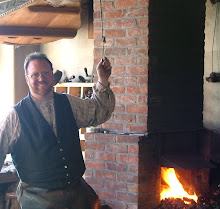In the traditional Blacksmith shop at The Farmers’ Museum we make and repair tools as needed. Several times a year we need to make a new ash hammer handle. We have discussed in the past how a
Froe is used to split out the billets of wood to make the handles. Then we use the drawknife and
Shaving Horse to shape the handle. But where to we get the billets of wood to start with? They don’t look like modern lumber.
We are fortunate to have many acres of forest as part of our farm. This fall both Hurricane Irene and Tropical Storm Lee brought high winds to our area this fall (2011). Several mature Ash trees were uprooted in the woods. As the damage is cleared we put aside some logs to make tool handles and other things. One foot, two foot, and three foot sections went in the shed to make hammer and sledgehammer handles.
Using an axe, a sledge and wedges, and a mallet and froe we split up the wood into billets to dry for future tool handles. First the logs were split into halves, then quarters, then eighths. Sap and heart wood is split off if it looks weak. Knotty pieces not good for handles go into the kindling pile.
The Froe is used to split off the bark and wet cambium layer. The resulting billets are sqaure or keystone shaped in cross section. This will let the handle billets dry evenly and be less likely to check.
Some may be used for hammers. Other to make chisel, screwdriver, or file handles. It is good to have a stockpile against future need.







Handles that are split out are a heap-sight better than the sawn-out junkers in the stores. The old man across the road used to make mine, but he's been gone for years now. I've done enough wood-working that I really don't have any excuse for not making my own.
ReplyDeleteHi Steve,
ReplyDeleteI came across your blog and, based upon you blacksmithing background, I thought you'd be a great fit for a product review on behalf of my client, Magid Glove. They are interested in giving away heavy duty, cut and fire resistant aprons for review
http://www.magidglove.com/Magid-A24X24KV-Yellow-Kevlar-Bib-Style-Apron-with-Split-Leg-A24X36KV-1.aspx
If interested please email me back at eromero@straightnorth.com
Thanks,
Edwin Romero
I'd love to know more about making handles, from start to finish - could you do a step-by-step tutorial? I am a noobie blacksmith living in Colorado, trying to slowly put things together for a shop. I've been slowly procuring items and have many hammer heads, punches and cutters, all missing handles. Being that I'm lacking funds, making my own handles would save me money and teach me a lot. I've got several files (farrier rasp and bastard files), a vice, and the desire to learn the art of patience and practice. Have any advice or further assistance in making handles? I'd love to hear some wisdom. - Jenny (cavescaper@gmail.com)
ReplyDeleteDear,
ReplyDeleteI Own Imp. & Exp. Company And Want To Trade In Logs That Are Strengthened Enough To Be Hammer Handles & Pickaxes & Hoes Handles.
So, Is The Beech Logs Are Okay For That Or Which Type Is Comfortable For That ?!
Please, Reply As Soon As Possible As This Is Very Urgent!!
Thanks And Regards
Ahmed Arafa
Email: arafa.bros@hotmail.com